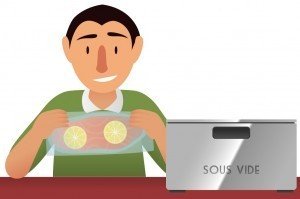Sous Vide Cooking and Food Safety
 Is sous vide cooking safe?Let’s take a closer look. Sous vide (pronounced soo-veed) is not a new process — it’s been around for several decades in Europe. The term is French for “under vacuum,” and refers to a method of cooking wherein food is placed in a pouch and vacuum-packed. The pouch is then put in a water bath and cooked slowly at a low temperature. Some foods are served directly from the bag while others are finished with a quick sear to achieve crispy edges, deeper flavor, and/or dramatic color.The foods that lend themselves best to sous vide cooking are usually protein foods like eggs, poultry, meats, and fish. In order to produce safe results, cooks need to follow very precise procedures with exact temperature and time combinations. In some cases, the cooking temperatures are well below what are conventionally recommended.Therefore, it should come as no surprise that there are some food safety concerns associated with this method of cooking. Sous vide cooking may result in raw or undercooked foods, which have a higher risk of causing foodborne illnesses from bacteria, viruses, or parasites. If it is done wrong, it could be dangerous and allow for the development of pathogens such as Listeria, Clostridium perfringens, Salmonella, and/or E.coli! A major concern is the potential for survival and growth of bacteria at these low temperatures for an extended amount of time. Another concern is the vacuum-packed bag. Vacuum packing removes or reduces the oxygen content inside the bag. This creates just the right conditions for Clostridium botulinum to develop.On the other hand, proponents say that cooking food at lower temperatures results in improved quality, newer textures, better moisture retention, more tender foods, and more intense flavors. Those who are willing to take the risk must pay serious attention to food safety. In fact, in most states, restaurants that want to cook using sous vide methods need to apply for a variance and submit a safety plan to their local regulatory agency. Sous vide chefs that are aware of the potential risks can successfully manage these food safety concerns.For home cooks, food safety can be complicated. There are so many variables. Home cooks who want to try sous vide cooking should proceed with caution. Make sure to use well-tested equipment and follow the manufacturer’s instructions. Rely on well-researched recipes to avoid experimenting with the family’s health.By Cheryle Jones Syracuse, MS, Professor Emeritus at The Ohio State UniversityPS: Here's a link to important sous vide information: http://www.fsis.usda.gov/OPPDE/rdad/FRPubs/95-033F/95-033F_Appendix%20A.htm
Is sous vide cooking safe?Let’s take a closer look. Sous vide (pronounced soo-veed) is not a new process — it’s been around for several decades in Europe. The term is French for “under vacuum,” and refers to a method of cooking wherein food is placed in a pouch and vacuum-packed. The pouch is then put in a water bath and cooked slowly at a low temperature. Some foods are served directly from the bag while others are finished with a quick sear to achieve crispy edges, deeper flavor, and/or dramatic color.The foods that lend themselves best to sous vide cooking are usually protein foods like eggs, poultry, meats, and fish. In order to produce safe results, cooks need to follow very precise procedures with exact temperature and time combinations. In some cases, the cooking temperatures are well below what are conventionally recommended.Therefore, it should come as no surprise that there are some food safety concerns associated with this method of cooking. Sous vide cooking may result in raw or undercooked foods, which have a higher risk of causing foodborne illnesses from bacteria, viruses, or parasites. If it is done wrong, it could be dangerous and allow for the development of pathogens such as Listeria, Clostridium perfringens, Salmonella, and/or E.coli! A major concern is the potential for survival and growth of bacteria at these low temperatures for an extended amount of time. Another concern is the vacuum-packed bag. Vacuum packing removes or reduces the oxygen content inside the bag. This creates just the right conditions for Clostridium botulinum to develop.On the other hand, proponents say that cooking food at lower temperatures results in improved quality, newer textures, better moisture retention, more tender foods, and more intense flavors. Those who are willing to take the risk must pay serious attention to food safety. In fact, in most states, restaurants that want to cook using sous vide methods need to apply for a variance and submit a safety plan to their local regulatory agency. Sous vide chefs that are aware of the potential risks can successfully manage these food safety concerns.For home cooks, food safety can be complicated. There are so many variables. Home cooks who want to try sous vide cooking should proceed with caution. Make sure to use well-tested equipment and follow the manufacturer’s instructions. Rely on well-researched recipes to avoid experimenting with the family’s health.By Cheryle Jones Syracuse, MS, Professor Emeritus at The Ohio State UniversityPS: Here's a link to important sous vide information: http://www.fsis.usda.gov/OPPDE/rdad/FRPubs/95-033F/95-033F_Appendix%20A.htm


